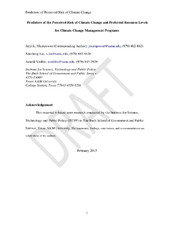| dc.description.abstract | In a 2013 U.S. national public opinion survey, data were collected from 1,321 adult respondents for five psychometric variables—Dread, Scientists’ Level of Understanding, Public’s Level of Understanding, Number Affected, and Likelihood—for six threats (sea level rise, increased flooding, and four others) associated with climate change. Respondents also rated Perceived Risk and indicated the Resource Level that they believed should be invested in management programs for each threat. Responses did not vary significantly across the six threats, so they were combined. The survey collected standard demographic information, as well as measuring Climate Change Knowledge (CCK) and environmental values (New Ecological Paradigm, NEP). Psychometric variables predicted Perceived Risk extremely well (R = .890, p < .001); all five psychometric variables were significant predictors. The results were generally consistent with previous research except that Scientists’ Level of Understanding was a positive, rather than negative, predictor of Perceived Risk. Jointly the demographic, knowledge and environmental values variables significantly predicted Perceived Risk (R = .504, p < .001). Consistent with previous research, significant positive predictors were Age, Democratic Party identification, and NEP score; significant negative predictors were Male gender and White ethnicity. When demographic, knowledge, and environmental values variables were added to psychometric ones, only the psychometric variables were statistically significant predictors. Perceived Risk strongly predicted Resource Level (r = .772, p < .001). Adding demographic, knowledge and environmental value variables to Perceived Risk as predictors of Resource Level did not appreciably increase overall predictive ability (r = .790, p < .001), although White ethnicity emerged as a significant negative predictor and Religiosity, Democratic Party ID, Liberal Political Ideology, and NEP score were significant positive predictors. The results demonstrate that risk perceptions of climate change and policy preferences among climate change management options are highly predictable as a function of demographic, knowledge, environmental values, and psychometric variables. Among these, psychometric variables were found to be the strongest predictors. | en |
| dc.description.sponsorship | This material is based upon research conducted by the Institute for Science, Technology and Public Policy (ISTPP) in The Bush School of Government and Public Service, Texas A&M University. The statements, findings, conclusions, and recommendations are solely those of the authors. | en |


